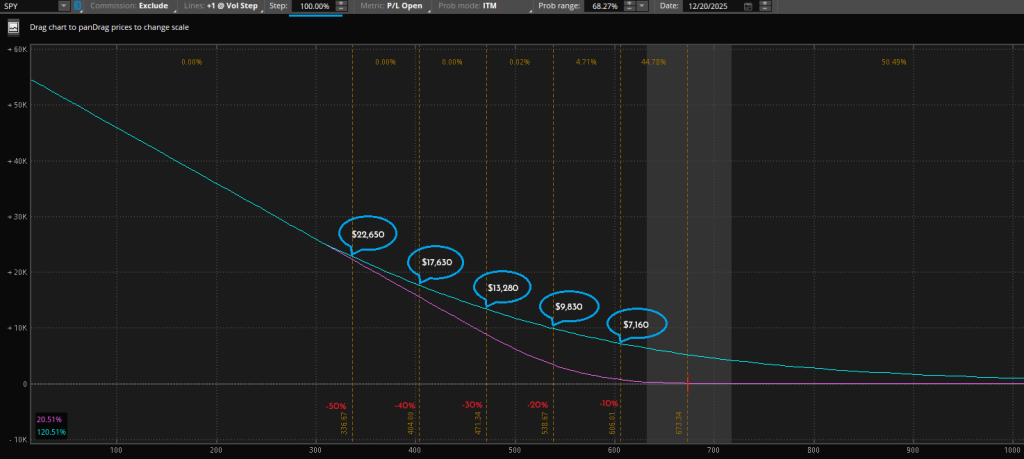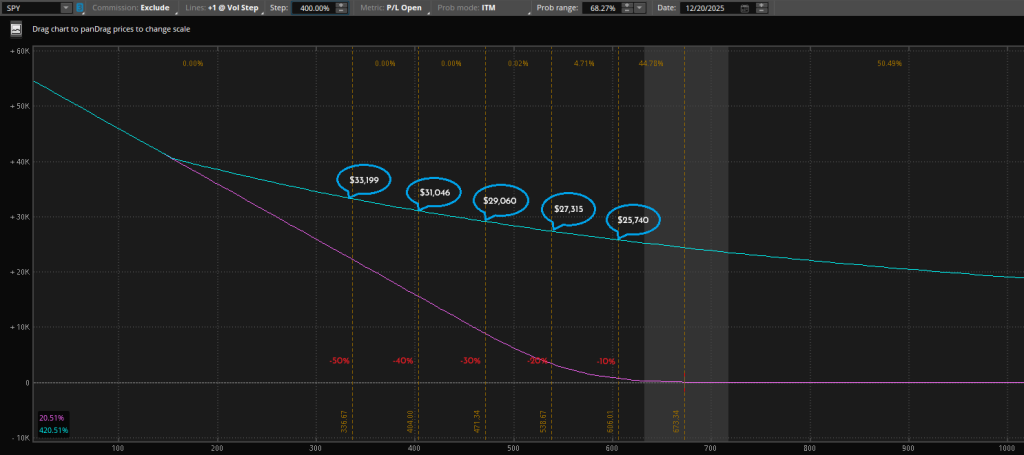“For God so loved the world that He gave His one and only Son, that whoever believes in Him shall not perish but have eternal life.” John 3:16
Hello again, today I wanted to discuss how I’ve built or am building an income insurance portfolio to protect against market corrections. But first, you should know the capital allocated here isn’t intended to increase in value, as most investments should. Rather, this capital is set aside solely for the purpose of market insurance.
That said, if you’re just getting started and capital is sparce there are some things you can do. Still, generally, capital committed to insurance is a sunk cost until disaster strikes. I for one prefer to be ready. Let’s get into it.
For those just considering this concept here is a terrific primer from Medium.com, “Portfolio Protection with Options: A Comprehensive Guide to Safeguarding Your Investments”.
Post Agenda
- Building an Income Insurance Portfolio Overview
- Capital Requirements
- Selecting an Appropriate Insurance Policy

Building an Income Insurance Portfolio Overview
To get started, we need to first identify what it is I’m talking about. What is income insurance?
An income focused portfolio designed to generate high yield. Yield that once received will then be used to buy put options as insurance. Sound good? Let’s unpack it.
To begin, the first steps will be deciding how much capital can be earmarked and set aside. Further, depending on risk tolerance more or less capital will be required. For example, the more risk averse investor will prefer safer lower yielding assets. The riskier investor, more speculative higher yield assets will be targeted.
Once balance and assets are determined, the next step would be to buy some put options. Again, the art here is determining the cheapest “policy” that provides adequate protection. I cannot say I have a full proof plan in this regard. Still, I just accept that losses will occur and it’s better to have some puts than none at all.
All together, the plan is to create enough income from investments to finance the purchase of insurance. I’m not a fan of wasting limited capital resources. For those that have accepted insurance is just a part of life, this approach may seem futile. They may prefer to just pay for the puts outright as protection. Either way, the portfolio is protected.
The hope is by generating enough yield and balancing that with growth the portfolio will become self sustaining. Always spinning off enough income to remain protected. Only time and the next financial disaster will prove me right or wrong.
Capital Requirements
This will be determined almost entirely by how large a portfolio is being protected. Personally, I have about $100,000 so I’ll use that as my target as we work through how much capital is needed. For those with more, more capital will be necessary. However, when uncertainty is high, more capital may be desirable.
With that, let’s walk through my approach to protecting my $100,000 dollar portfolio.
Let’s assume I’ve allocated $7,000 dollars to this portfolio. The goal now would be to select assets that generate enough yield to meet my insurance requirements. Again, more art than science in my opinion. Regardless, let’s approach it with firm numbers to make the point.
Further, assume $100 per month or $1,200 per year is the cost of put insurance. This changes as the market changes so I actually aim for a higher yield. Hence the art. In any case, I need to generate somewhere near 17% in yield to finance my yearly insurance cost. Preferably more but I also need to balance some growth so the portfolio doesn’t just decay.
Assuming a $7,000 portfolio and $1,200 per year in cost I decide I can reach my target with; SPYG, QQQT, & MSFY. One growth focused asset and two high yield assets. At current, QQQT provides 21.83% in yield and MSFY offers 36.92%. Remember though, this yield will fluctuate as price changes or payouts increase or decrease.
Capital Allocation
- $1,500 – SPYG
- $2,750 – QQQT
- $2,750 – MSFY
Using the current yield we may receive;
- SPYG – $1,500 * 0.53% = $7.95
- QQQT – $2,750 * 21.83% = $600.32
- MSFY – $2,750 * 36.92% = $1,015.30
- Total = $1,623.57/year
This provides a little over $400 per year as a buffer for market changes and yield variance. Some may prefer a higher buffer, less risk, more risk, or even more growth. Still, this achieves the target of $1,200 per year and provides a framework for building an income insurance portfolio of your own.
Selecting an Appropriate Insurance Policy
I’m certain there are 100 ways to approach this. The link above from Medium.com will layout a more logical approach than my own. For me, I try to buy as much vega as my budget will allow. Again, balancing a sustainable portfolio with adequate protection. If I’m able to pay less for insurance and redeploy capital into my investments, that’s a win. My dividend increases and my portfolio remains protected.
I approach this from the analyze tab on Thinkorswim. I’m not sure what other tools exist that match this capability but It’s free to open an account at Schwab.com.
I already determined a monthly insurance budget of $100 so I don’t complicate this, I just go to the expiration date nearest 30 DTE. Then, I find the put option nearest the $100 dollar budget. From there, I select it and move it to the analyze tab of Thinkorswim. Once inside the analyze tab I adjust the setting to show contract values as volatility changes. One caveat to this approach that I also try to perform is buying further dated options. I won’t go into it in this post but essentially I’ll spend $200 for 60 DTE or $300 for 90 DTE, etc. The hope being, maybe I can save a little premium over time by closing the option inside the 30 DTE window, when decay happens faster.
Now, before I go on it’s important to mention something here. Volatility is a fickle thing. From my experience and research, volatility during sustained bear markets roughly doubles. Meaning, the VIX index moves from an average of, say $10, to an average of $20. However, during extreme turbulence or a market crash, it would go from $10 to $50 or higher. So for further discussion, let’s assume a 100% volatility increase as we consider the put insurance. Obviously, in a crash, we would get more bang for our insurance buck and I’ll show you what I mean below.
Thinkorswim Insurance Analysis
Here is an image that highlights what would happen to a put option expiring in 34 days that costs $95.

Assuming volatility increased by 100% during the life of this option you could see the possible outcomes. I’ve highlighted the put insurance profit at the 10 – 50% levels. If the market cratered 50% the most I could receive from this “insurance” is $22,000. That doesn’t quite cover what a 50% drop in my portfolio would look like. On a $100,000 portfolio a 50% decline would net out to; $100k * -50% + $22k = $72,000. Still a loss of $28,000 but a far cry from the $50,000 loss with no protection at all.
At this point, you would have to decide if the cost of insurance is worth adding more puts. Obviously, to remain fully protected at least 1 or 2 more put options would be needed. Though, the put insurance costs increase as well. For me, I’ve accepted that losses will come, I just try to mitigate that loss to the best my budget will allow.
Finally, before we move on, here is an image of that same put option if volatility increased by 400%. Possible in periods of extreme volatility and this is what I was referring to above by more bang for our buck.

Essentially, if volatility explodes higher, those puts become exponentially more valuable. While a 400% increase isn’t likely we did see similar increases during the 2008 financial crisis and the 2020 covid pandemic so anything is possible. All in all, when building an income insurance portfolio the goal is to generate enough income to provide an adequate level of protection. Too much protection is great but it comes at a sustained cost. That sustained cost my prohibit the portfolio from operating as intended and more capital may be needed. I prefer the sustainable approach but I can also always increase protection strategically.
Final Thoughts
First, if you’re interested to continue reading about how I protect my portfolio here is an article I did a couple of months ago, “The Importance of Portfolio Insurance”. Inside I walk through a similar discussion that may provide more context or another perspective.
Regardless, the message I hope to convey should be clear, portfolio insurance is critical at a time when everything feels out of whack. I mean, who among us can honestly say they feel like we’re in a strong economic place? I certainly don’t and haven’t for a while. So rather than try an time the next decline and go to cash, I just focused on building and income insurance portfolio.
I don’t over analyze this and I’ve accepted that I won’t catch the highest values as volatility changes. If I can offset really any loss to my overall portfolio then I’ll consider it a win. Moreover for those with time and capital, it would be fully possible in my opinion to catch those instances when volatility spikes to an extreme.
Lastly, the one downside here that I wrestle with is knowing when to close my put and accept the protection payment. Has the market reached a bottom or do I hold on for more downside? That’s the biggest question and one that requires a strategy all it’s own but I’ll save that conversation for another day.
Until the next post.
God bless,
Jeff









